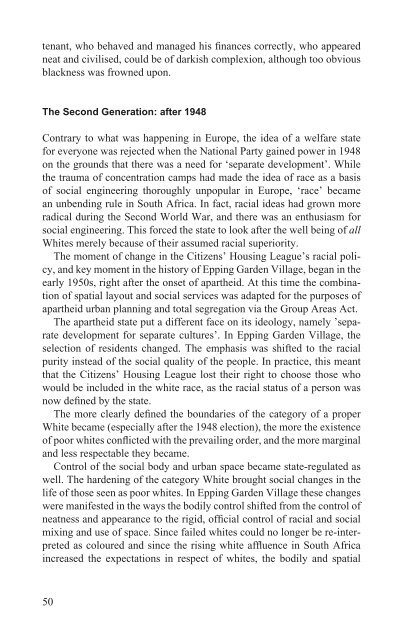The Making of a Good White - E-thesis - Helsinki.fi
The Making of a Good White - E-thesis - Helsinki.fi
The Making of a Good White - E-thesis - Helsinki.fi
Create successful ePaper yourself
Turn your PDF publications into a flip-book with our unique Google optimized e-Paper software.
tenant, who behaved and managed his <strong>fi</strong>nances correctly, who appeared<br />
neat and civilised, could be <strong>of</strong> darkish complexion, although too obvious<br />
blackness was frowned upon.<br />
<strong>The</strong> Second Generation: after 1948<br />
Contrary to what was happening in Europe, the idea <strong>of</strong> a welfare state<br />
for everyone was rejected when the National Party gained power in 1948<br />
on the grounds that there was a need for ‘separate development’. While<br />
the trauma <strong>of</strong> concentration camps had made the idea <strong>of</strong> race as a basis<br />
<strong>of</strong> social engineering thoroughly unpopular in Europe, ‘race’ became<br />
an unbending rule in South Africa. In fact, racial ideas had grown more<br />
radical during the Second World War, and there was an enthusiasm for<br />
social engineering. This forced the state to look after the well being <strong>of</strong> all<br />
<strong>White</strong>s merely because <strong>of</strong> their assumed racial superiority.<br />
<strong>The</strong> moment <strong>of</strong> change in the Citizens’ Housing League’s racial policy,<br />
and key moment in the history <strong>of</strong> Epping Garden Village, began in the<br />
early 1950s, right after the onset <strong>of</strong> apartheid. At this time the combination<br />
<strong>of</strong> spatial layout and social services was adapted for the purposes <strong>of</strong><br />
apartheid urban planning and total segregation via the Group Areas Act.<br />
<strong>The</strong> apartheid state put a different face on its ideology, namely ’separate<br />
development for separate cultures’. In Epping Garden Village, the<br />
selection <strong>of</strong> residents changed. <strong>The</strong> emphasis was shifted to the racial<br />
purity instead <strong>of</strong> the social quality <strong>of</strong> the people. In practice, this meant<br />
that the Citizens’ Housing League lost their right to choose those who<br />
would be included in the white race, as the racial status <strong>of</strong> a person was<br />
now de<strong>fi</strong>ned by the state.<br />
<strong>The</strong> more clearly de<strong>fi</strong>ned the boundaries <strong>of</strong> the category <strong>of</strong> a proper<br />
<strong>White</strong> became (especially after the 1948 election), the more the existence<br />
<strong>of</strong> poor whites conflicted with the prevailing order, and the more marginal<br />
and less respectable they became.<br />
Control <strong>of</strong> the social body and urban space became state-regulated as<br />
well. <strong>The</strong> hardening <strong>of</strong> the category <strong>White</strong> brought social changes in the<br />
life <strong>of</strong> those seen as poor whites. In Epping Garden Village these changes<br />
were manifested in the ways the bodily control shifted from the control <strong>of</strong><br />
neatness and appearance to the rigid, <strong>of</strong><strong>fi</strong>cial control <strong>of</strong> racial and social<br />
mixing and use <strong>of</strong> space. Since failed whites could no longer be re-interpreted<br />
as coloured and since the rising white affluence in South Africa<br />
increased the expectations in respect <strong>of</strong> whites, the bodily and spatial<br />
50
















